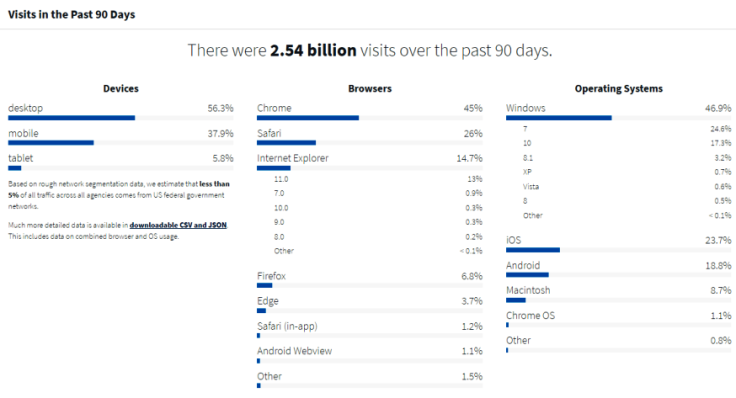Windows vs. iOS: Which Is The More Popular OS?

Not much has changed for Microsoft’s Windows operating system from 2015 till now, at least not in terms of being the most preferred end-user OS. According to data from the Federal Digital Analytics Program (DAP) — based on visits to U.S. government websites — Windows, with all of its many versions, is the most popular end-user OS, and has 46.9 percent market share in the country.
Second in line are OS from Apple, with iOS having a 23.7 percent market share and MacOS 8.7 percent, for a total of 32.4 percent. The third spot is taken by Android, which is 18.8 percent of the user base.

However, despite being the most popular OS, Windows is losing its grip on the market. According to the same report, Windows OS has seen a remarkable drop in popularity from March 2015, when it had a market share of 58.4 percent of all government website visitors. With less than half the visitors to the federal government's websites coming from Windows now, what is causing the shift?
The main reason behind the decline is the rising usage of smartphones. The data on devices used by visitors shows a dramatic change in just the last three months. In January, personal computers accounted for 59 percent of the total government website visitors and smartphones accounted for 35.1 percent. By the end of March, desktop visitors dropped to 56.3 percent and the smartphone users increased by almost 3 percent to 37.9 percent.
Looking at the breakdown of Windows OS, it turns out Windows 7 is still on top, with 24.6 percent standalone market share. The OS was originally released in 2009 but is still a popular operating system. According to NetMarketShare, Windows 7 had an estimated market share of 48.3 percent globally in December 2016.
However, Microsoft wants all its users to shift to Windows 10, and the company confirmed in a post it will no longer support Windows 7 starting Jan. 14, 2020. Will Microsoft still continue to provide support for the popular OS after that? Yes and no.
As per Microsoft’s Windows Lifecycle support FAQ, “All desktop operating system products, whether used for personal or business, receive a minimum of 10 years of support (minimum of five years Mainstream Support and minimum of five years Extended Support) at the supported service pack level.”
However, a Microsoft Knowledge Base article states, “Because of how this support policy is implemented, Windows 8.1 and Windows 7 devices that have a seventh generation or a later generation processor may no longer be able to scan or download updates through Windows Update or Microsoft Update.”
The DAP data is based on 2.54 billion visits over the past 90 days to almost 500 executive branch government domains across 5,000 websites.
© Copyright IBTimes 2024. All rights reserved.





















